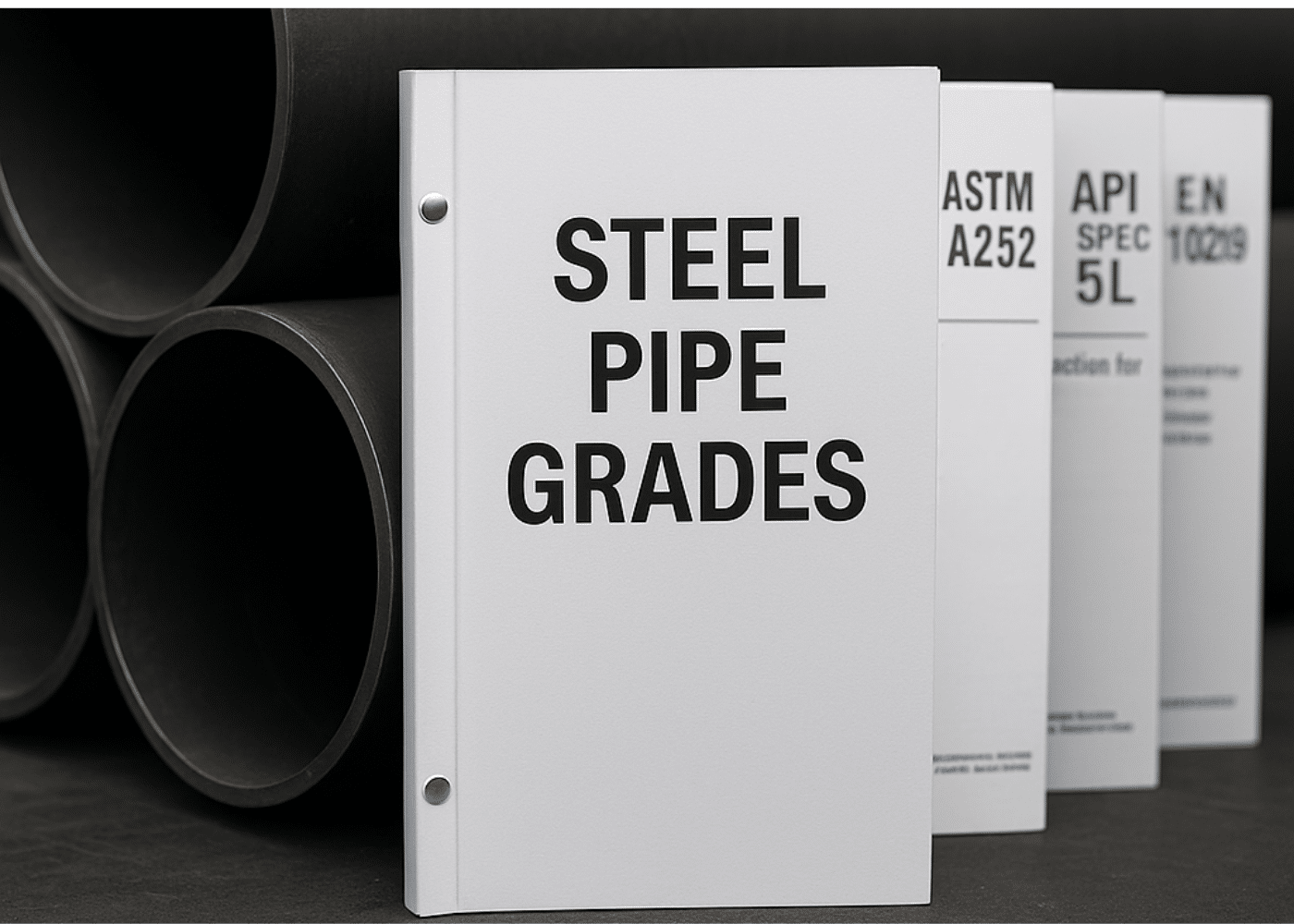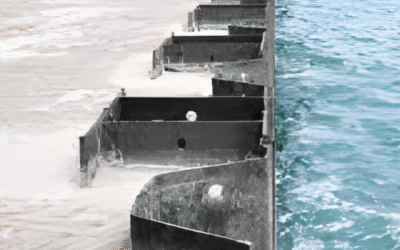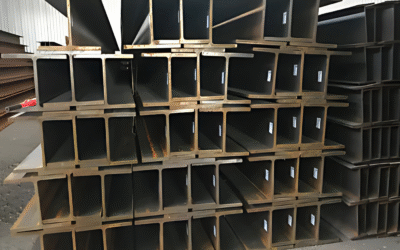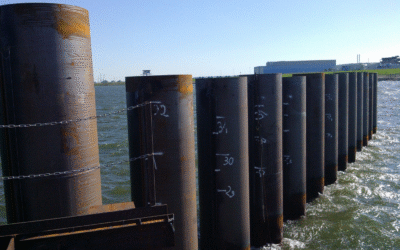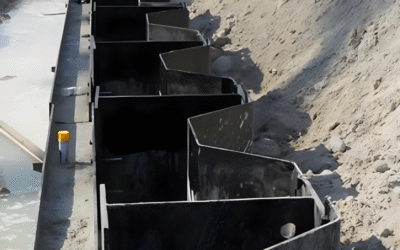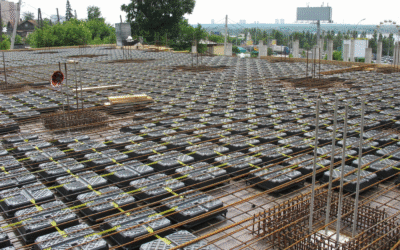What Makes Steel Pipe Grades and Standards So Important?
Selecting the right steel pipe is about far more than its nominal pipe size, outside diameter or wall thickness. Each pipe’s grade, material composition, and manufacturing standard define its chemical and mechanical properties, durability, and long-term performance.
For engineers, procurement teams, and contractors, understanding steel pipe grades and industry standards such as ASTM, EN, ASME, and API specifications is essential to ensuring design integrity, compliance, and cost-efficient construction. Whether used as line pipe in gas transmission or as structural piles in marine foundations, selecting the correct steel pipe grade and standard ensures performance under both high or low pressures.
This guide explains the most commonly used steel grades for pipes, global production industry standards, and coating requirements that ensure durability and reliability in various applications.

What Factors Determine Which Steel Material Is Required?
Before choosing a steel grade or manufacturing standard, engineers must determine the correct material category based on:
- Load-bearing capacity and stress levels
- Corrosion exposure (marine, industrial, buried)
- Temperature conditions (high or low)
- Fatigue demands (offshore, bridges)
- Budget and lifecycle cost
Material categories and when they are chosen:
The performance, weldability, and durability of steel pipes depend primarily on their material composition.
In piling, structural, and marine applications, most pipes are produced from low-carbon or low-alloy steels, offering the right balance of strength, weldability, and cost efficiency.
Stainless and high-alloy steels are reserved for specialised applications exposed to extreme corrosion, temperature, or pressure conditions, where standard piling grades would not suffice.
1. Carbon Steel Pipe – The Industry Standard
Carbon steel remains the most widely used base material for both seamless and welded pipes. It combines affordability, mechanical strength, and ease of fabrication, making it ideal for piling, oil and gas transport, water systems, and structural frameworks.
Common standards and grades:
- EN 10025: S235, S275, S355 – general structural steels used for pipe piles and foundations.
- ASTM / API: A106, A53, A252, API 5L (Gr.B, X42–X70) – used for pressure, line, and piling applications worldwide.
Typical composition: 0.15–0.25% carbon with controlled additions of manganese (Mn), silicon (Si), and trace elements (Cr, Cu, Ni) to improve strength and weldability.
This results in a tough yet ductile steel capable of withstanding impact and dynamic loads in challenging environments.
Carbon steels like S355 and A252 are preferred in piling and structural works for their balanced combination of strength, ductility, and weldability.
Pipeline grades, such as API 5L, focus on pressure containment, toughness, and reliability under internal pressure, making them ideal for transporting oil, gas, and water.
Key takeaway: Carbon steels provide a strong, economical foundation for most structural applications, provided they are adequately protected against corrosion.
2. Low-Alloy Steel – Enhanced Strength and Toughness
While carbon steels cover most standard applications, low-alloy steels are specified when projects demand higher yield strength, better fatigue performance, or reliable toughness in cold climates.
These steels are still primarily iron and carbon, but they contain small amount of added alloys (usually <5%) such as nickel, chromium, molybdenum, or vanadium, enhancing mechanical performance without compromising weldability.
Typical grades:
- EN 10025: S420, S460
- ASTM / API: A572 Gr.50, A333 Grade 6 (low-temperature applications)
Advantages:
- Improved strength-to-weight ratio
- Superior toughness and fatigue resistance
- Maintains strength and toughness under cyclic loading and low-temperature conditions.
Such grades are often used in offshore, bridge, or marine piling projects where additional robustness is essential but full high-alloy chemistry would be uneconomical.
Example: In North Sea or Baltic port structures, S460-grade pipe piles provide higher stiffness for deep foundations while maintaining weldability.
3. Stainless Steel and High-Alloy Steel – For Corrosion Resistance
Stainless and high-alloy steels represent a smaller, specialised category used when corrosion resistance, temperature tolerance, or chemical stability are critical.
Stainless steel pipes are not typical for structural piling but are found in process piping, chemical plants, or offshore topside systems exposed to harsh marine or chemical environments.
Common types:
- A312 TP304 / TP316 – austenitic stainless steels used in chemical, water treatment, and offshore process piping.
- A335 P11 / P22 – chromium-molybdenum alloys for high-temperature service.
- A333 Grades – low-temperature alloys used in cryogenic systems.
Advantages:
- Exceptional corrosion resistance
- Stable mechanical performance in extreme temperatures
- Long service life with minimal maintenance
However, due to their higher cost and limited availability, these steels are rarely used in sheet pile walls, combi walls, or standard foundation piles.
In marine construction, such materials are typically reserved for critical connections, riser systems, or components requiring both mechanical strength and corrosion resistance — not for standard pile foundations.
4. Practical Insight for Piling and Structural Works
In most marine, port, and infrastructure projects, low-carbon and low-alloy steels (S355–S460, A252, API 5L) offer the best balance of performance, availability, and cost.
Stainless and high-alloy materials remain niche options, justified only when corrosion rates or temperature fluctuations exceed the limits of coated carbon steel.
Note: Regardless of grade, all steel pipes require protective systems, such as epoxy coatings, galvanisation, or cathodic protection, to ensure long-term service life in marine or buried environments.
Summary
|
Material Type |
Common Standards |
Key Grades |
Typical Use |
Remarks |
|
Carbon Steel |
EN 10025 / API 5L / ASTM A252 |
S355, API 5L X52 |
General piling, oil & gas, water lines |
Most economical, reliable option |
|
Low-Alloy Steel |
EN 10025 / A572 / A333 |
S460, A572 Gr.50 |
Offshore, bridges, cold regions |
Higher strength and toughness |
|
Stainless / High-Alloy |
A312 / A335 / A333 |
304, 316, P11 |
Process piping, chemical plants |
Excellent corrosion resistance, high cost |
Selecting the material type sets the foundation for grade selection.
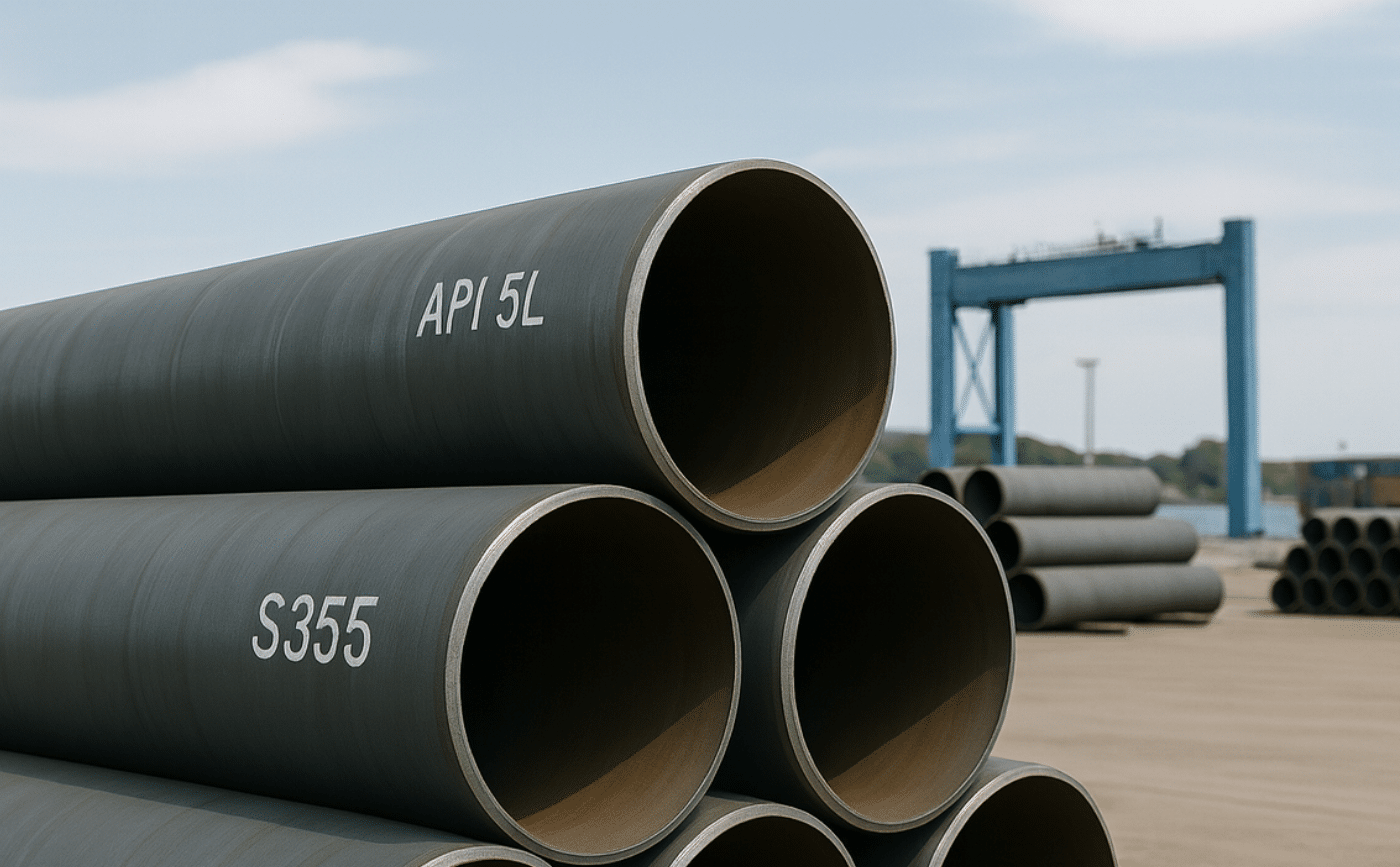
How to Select the Right Steel Pipe Grade After Choosing the Material Type?
Once the material category is defined (carbon, low-alloy, stainless), engineers select a steel grade that meets the project’s chemical and mechanical property requirements.
For example:
- Carbon steel → S355, ASTM A252 Gr.3, API 5L Grade B or X52
- Low-alloy steel → S420, S460, A572 Gr.50, A333 Gr.6
- Stainless → TP304, TP316, A335 P11 / P22
Steel grades provide a predictable framework for comparing:
- Yield strength
- Tensile strength
- Weldability
- Impact toughness
- Corrosion resistance
- Allowable stress
- Suitable environment
Examples:
- Piling & structural: S355J2H, ASTM A252 Gr.3
- Offshore wind & marine: S420–S460, API 5L X52–X65
- Process piping: A312 TP316
- Low-temperature service: A333 Grade 6
Grades, therefore, serve as the bridge between material type and engineering performance requirements.
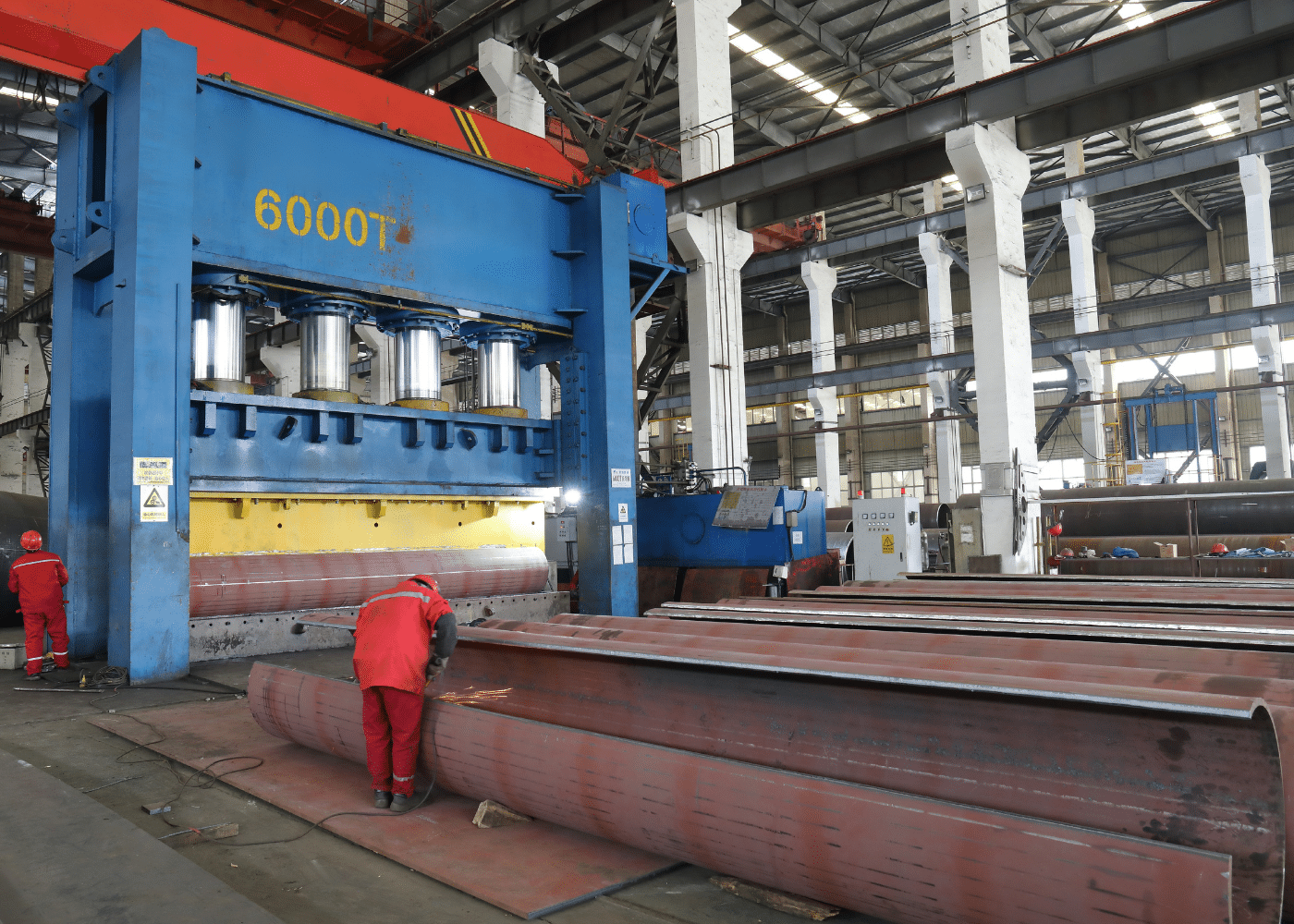
Which Manufacturing Methods Must Be Considered Before Selecting a Standard?
Manufacturing method directly affects mechanical properties, weld quality, tolerances, and cost. Engineers must choose the method that fits the application.
Main manufacturing processes:
Seamless pipes (SMLS)
- No weld seam
- Higher strength and uniformity
- Used in high-pressure or high-temperature applications
- Common in API 5L, ASTM A106, A333
Welded pipes
Includes:
- LSAW (Longitudinal Submerged Arc Welded) — heavy-duty, precise, ideal for large-diameter piles
- SSAW (Spiral Submerged Arc Welded) — cost-effective for large OD and long lengths
- ERW (Electric Resistance Welded) — used for structural and low-pressure systems applications
Hot-finished vs. cold-formed
- EN 10210 hot-finished: superior toughness, uniformity
- EN 10219 cold-formed: excellent dimensional accuracy, widely used for structural piles
Manufacturing choice affects the selection of standards, tolerances, testing requirements, and final pipe specification.

Which International Standards Define These Grades, Manufacturing Methods, and Performance Requirements?
Once the material type, steel grade and manufacturing method are selected, international standards determine how the pipe must be manufactured, tested, and certified to achieve the required performance level.
Standards such as API 5L, ASTM A252, ASTM A53, EN 10219, EN 10210, AS 1163, and DIN 2458 specify the following:
1. Manufacturing Method Requirements
- Seamless vs. welded steel pipes
- Longitudinal-welded (LSAW) or spiral-welded (SSAW)
- Electric Resistance Welding (ERW) tolerances and requirements
- Hot-finished vs. cold-formed structural sections
- Whether heat treatment is required (e.g., normalising, TMCP)
2. Chemical and Mechanical Requirements
- Chemical composition limits (C, Mn, Si, P, S, alloying elements)
- Minimum yield strength, tensile strength, and impact toughness
- Acceptable temperature ranges (for offshore, cryogenic, or high-temperature service)
3. Dimensional Requirements
- Pipe Wall thickness ranges and tolerances
- Pipe length tolerances (single, double, random length)
- Outside diameter, inside diameter, and ovality limits
4. Testing and Certification Requirements
- Hydrostatic testing
- Ultrasonic testing (UT) and radiographic testing (RT)
- Impact testing (Charpy V-notch)
- Hardness testing
- Mandatory Material Test Certificates (EN 10204 3.1 / 3.2)
- NDT acceptance levels
5. Delivery Condition and Surface Requirements
- Hot-rolled, cold-formed, normalised, quenched/tempered, or thermomechanically rolled
- Surface condition (bare, black, galvanised, coated)
6. Additional Application-Specific Requirements
- Pressure rating (API 5L / ASME B31.4 / B31.8)
- Weldability requirements
- Requirements for line pipe, piling pipe, structural hollow sections, or pressure pipe

What Are the Main Steel Pipe Grades Used Worldwide?
API 5L Grades
- Designed for gas transmission, oil pipelines, power plants and structural applications.
- Grades: A, B, X42, X52, X56, X60, X65, X70
ASTM A252 Grades (Gr.1–Gr.3)
- Industry standard for steel pipe piles.
- Grade 3 is most common due to high yield strength and uniform wall thickness.
ASTM A53 / A106
- Used for: low-pressure steam, water, gas lines, general structural use (A53)
EN 10025 / EN 10219 / EN 10210
- European standards for structural steels and hollow sections.
- Grades: S235, S275, S355, S420, S460
AS/NZS 1163
- Structural hollow sections used in Australia and New Zealand.
- Grades: C250, C350, C450
How Do Pipe Dimensions and Wall Thickness Affect Performance?
Every steel pipe is defined by:
- nominal pipe size (NPS)
- outside diameter (OD)
- inside diameter (ID)
- wall thickness
As wall thickness increases, pipes can withstand higher pressure and driving stresses but become heavier and require more welding power and crane capacity.
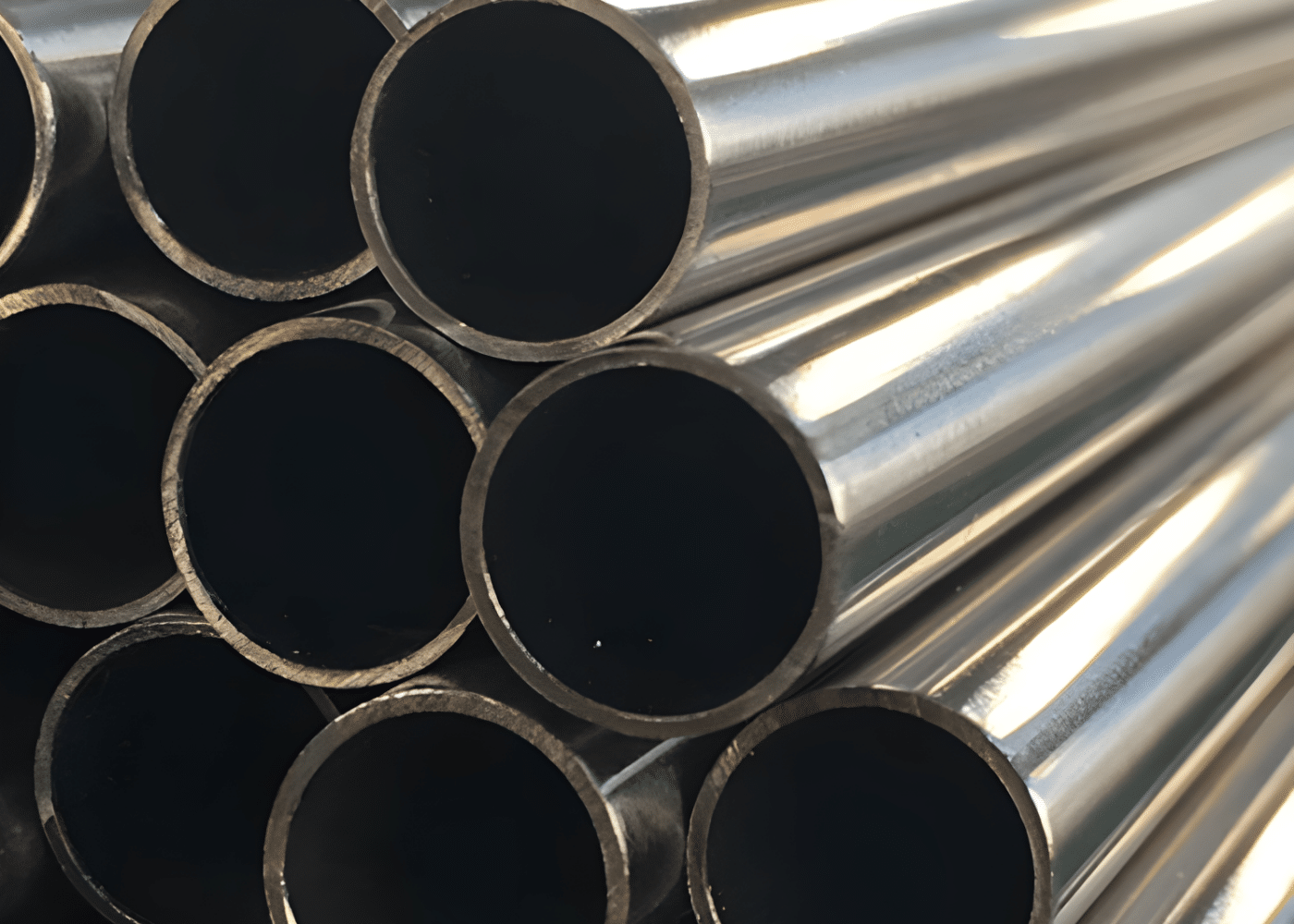
What Are the Key Takeaways for Engineers and Buyers?
Selecting the right pipe is a multi-layered engineering decision.
To ensure reliability and compliance across piling, marine, offshore, and structural applications:
- Begin with the engineering and environmental requirements, then define the appropriate material type.
- Choose a steel grade that delivers the required mechanical performance—yield strength, toughness, weldability, and chemical makeup.
- Specify the correct manufacturing method, based on diameter, wall thickness, driving stresses, and installation method.
- Reference the appropriate international standard to ensure dimensional tolerances, allowable stress limits, mechanical properties, and testing procedures are fully met.
- Apply appropriate coating systems for long-term durability.
A correct understanding of material types, steel pipe grades, manufacturing methods, and international standards ensures long-term durability, safety, and optimal performance in every project.
Related Products from Aema Steel
- Steel Pipe Piles
- Welded Seam Steel Pipes LSAW
- Spiral Welded Steel Pipes SSAW
- 2PE/3PE Anti-corrosion Pipes
- Anti-corrosion Pipes
- Combi Wall Systems
Contact us today to receive a tailored offer for your upcoming project.

